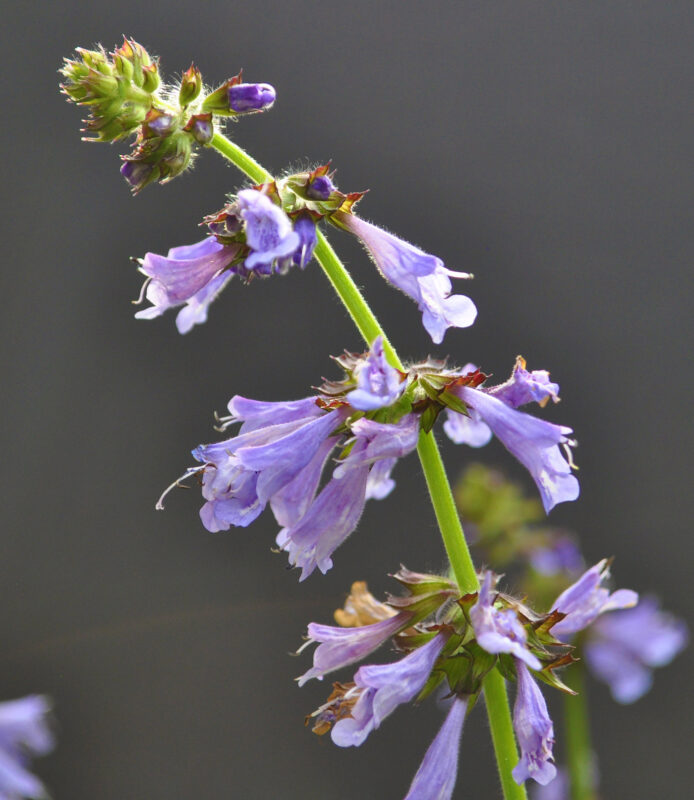By Lauri deGaris
According to the Merriam-Webster dictionary, a weed is a plant that is not valued where it grows and is usually vigorous, especially when it chokes out more desirable plants. Hence, we “weed” our garden or lawn to remove undesirable plants.
A flower is defined as a plant with single or clusters of colorful petals that produce nectar, seeds and fruit. Flowers flourish and bloom and are valuable for more than just their beauty. A perfect example is a flower that many people call a weed: lyreleaf sage.

“Florida Wild Flowers and Roadside Plants” by Bell and Taylor (1982) calls Salvia lyrate, also known as lyreleaf sage, “a common weed of lawns, pastures, open woods, and waste places throughout Florida and much of the Eastern United States.” After researching this flower, I conclude that Bell and Taylor’s description of lyreleaf sage as a weed and undesirable in the garden is flat-out wrong.
Salvus is Latin for whole, well-preserved, safe, healthy. And sage means wise. According to “Florida Ethnobotany” by Daniel Austin, the use of salvia as a medicine goes back to the Greeks and Romans. Many herbalists over the centuries have commented on the importance of all salvia species. In 1699, noted herbalist John Evelyn wrote, “tis a plant endu’d with so many and wonderful properties as that the assiduous use of it is said to render men immortal.”
Indigenous Americans have a long, rich history of using Salvia lyrate. The Catawba made a salve from the roots to treat sores. The Cherokee use it to treat a wide variety of illnesses. They mixed sage leaves with honey to help relieve asthma. Sage seeds are used to cure wounds when made into an ointment. Sage is a natural cleaning agent, pesticide, and ritual object. Spiritual uses of sage include burning or smudging. Learning to value the many species of salvia is sage advice.
At this time of year, lyreleaf sage is blooming all over our region. Over the past three years, I have worked to cultivate this plant in my yard. Each spring, I allow the lyreleaf sage to flower fully and collect the seeds. I scatter the seeds over my entire lawn. Gradually, I have replaced grass with sage, and it is lovely. After the flowers have gone to seed, I mow the lawn. Lyreleaf sage is an excellent ground cover that does not need fertilization or the use of insecticides or herbicides to flourish.

I love watching birds, bees and butterflies benefit from my lawn of purple sage. Many may consider my yard to be a bit untidy this time of year as the flowers flourish and feed early spring pollinators. But the work the insects are doing in my yard is very valuable. You may not like bugs, but according to Rebecca McMackin, one in every three bites of food we eat is a direct result of insect pollination.
Rebecca McMackin is an ecological horticulturist and director of horticulture at the Brooklyn Bridge Park, which sits in the middle of a concrete jungle — New York City. She recently gave a TED Talk titled “Let Your Garden Grow Wild” in support of local pollinators.
In the United States alone, we use 100 million pounds of insecticides, herbicides, and fertilizers on our lawns each year. She points out that gardens can be gorgeous and help the landscape around us by providing food, water, and shelter for wildlife. She is leading a movement to beautify gardens and landscapes so that we can share them with other creatures. She is calling this “biodiversity returns.”
What can you do to help biodiversity return to your yard? First, stop mowing and get rid of lawns. Rebecca tells us, “Lawns should be area rugs, not wall-to-wall carpets.” Leaves should be left on the ground. They are literally called leaves. We should leave them. Bees nest in leaves. Birds forage in leaves. And butterflies over-winter in leaves. Leaves also return valuable nutrients to the soil. Leave the leaves. No one will miss the sound of the leaf blowers, I promise!
I hope many will reconsider the traditional idea of lawns that display control over nature. As Rebecca points out, we do not need to be authoritarian in our garden design. We should stop being so tidy and allow ourselves and our gardens to go wild with plants that benefit us all.
I think Emily Dickinson’s poem, “A Little Madness in the Spring,” is absolutely appropriate and should be considered sage advice.
A little Madness in the Spring
Is wholesome even for the King
But God be with the Clown
Who ponders this tremendous scene
This whole Experiment of Green
As if it were his own!
— The Complete Poems of Emily Dickinson – Little, Brown & Company, NY, 1960.

I LOVE my lyreleaf sage! I’ve dedicated my yard to creating a native plant habitat for wildlife and butterflies. It’s frustrating when people spend SO much money to fertilize their “grass” to keep it pristine and perfect when all that does is degrade and destroy our water quality and provide nothing for animals. Wildflower meadows and native plants and grasses are far more beautiful AND beneficial and cost effective to maintain! Every year, I convert more and more of my yard to a mulched native plant part. What grass/plants that do grow are just what Mother Nature decides to plant there.
Plant native (not just Florida-Friendly) and be sure to tell Home Depot and Lowe’s and Liberty and everywhere else that sells plants that you want native plants. The only reason they sell non-natives is because that’s what people ask for and buy.